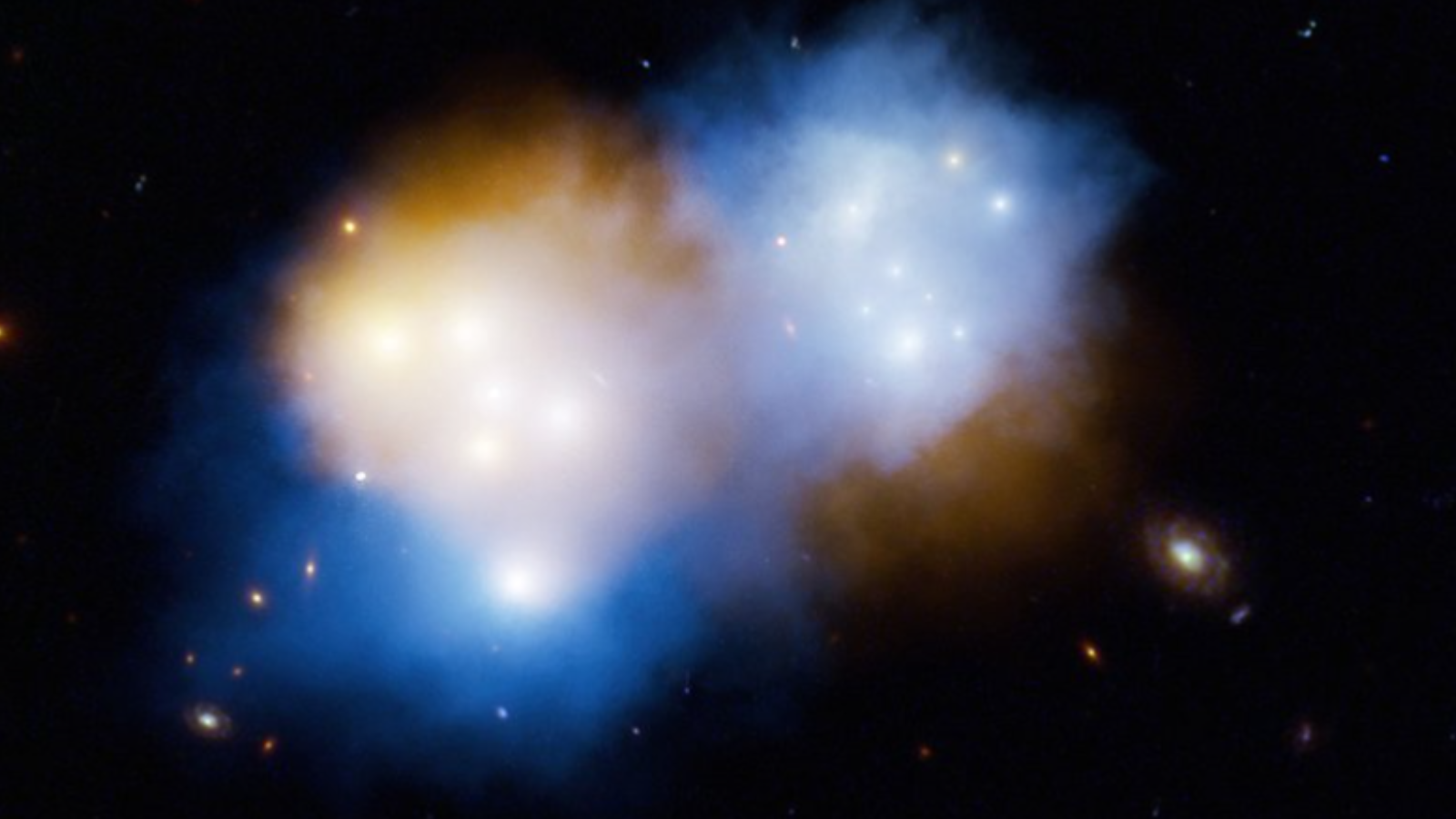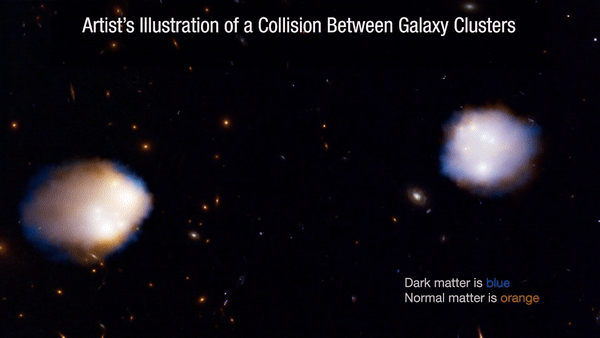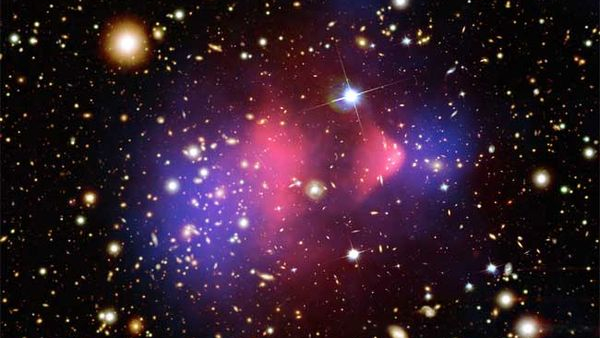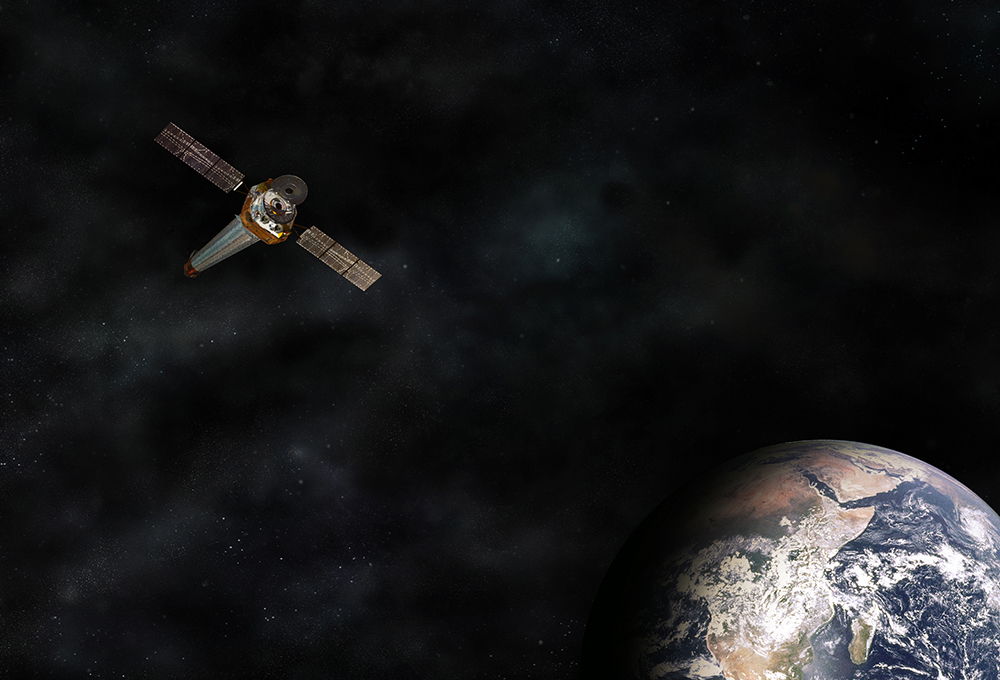Dark matter ghosts its way through powerful (and messy) collision of galaxy clusters
"These cluster collisions are the most energetic phenomena since the Big Bang."

Observing a distant and messy collision between galaxy clusters, astronomers have discovered that dark matter, the most mysterious "stuff" in the universe, passed through the wreckage like a cosmic phantom.
The dark matter was detected racing away from the conventional "normal" matter that comprises stars, planets, moons and everything we see around us in the colliding clusters. The galactic clusters "getting ghosted" in this research are part of a complex of thousands of galaxies that are collectively known as MACS J0018.5+1626, which is located around 5 billion light-years from Earth. Conglomerations like MACS J0018.5+1626 constitute the largest structures in the universe.
The individual galaxies of the colliding clusters escaped unscathed from this cosmic pile-up because of the vast space between them, but the dark matter content of those galaxies was even more untroubled by the incident.
To imagine what this collision looked like, study lead author Emily Silich, an astrophysicist at the California Institute of Technology (Caltech) in Pasadena, suggested picturing two dump trucks carrying sand smashing together.
Related: Rapidly spinning dead stars could unveil dark matter secrets
"The dark matter is like the sand and flies ahead," Silich said in a statement.
Scientists have detected dark matter racing ahead of normal matter in similar collisions before, but this new research, which used data collected by NASA's Hubble and Chandra space telescopes, represents the first time that researchers have been able to directly study the "decoupling" of the velocity of dark matter and "normal" matter.
Get the Space.com Newsletter
Breaking space news, the latest updates on rocket launches, skywatching events and more!

Silich and colleagues used a plethora of telescopes to observe the collision of MACS J0018.5+1626. In addition to data from Hubble and Chandra, the Caltech Submillimeter Observatory (until recently located on Maunakea in Hawai‘i), the W. M. Keck Observatory, the Planck Observatory, the Atacama Submillimeter Telescope Experiment, and the now-retired Herschel Space Observatory gathered data for the study.
The data doesn't just come from a vast array of instruments; it was also collected over the course of decades, with the analysis of the data itself taking years.
Giving up the ghost. How did dark matter give ordinary matter the slip?
The problem of dark matter hinges on the fact that it is is frustratingly "antisocial" when it comes to interacting with light, something that makes it nigh-invisible, and with ordinary matter.
It is this lack of interaction (or the fact that the interactions are too weak to see) that makes scientists think dark matter can't be made up of electrons, protons and neutrons, the baryonic particles that comprise the atoms that make up stars, planets, moons and everything else we see around us. That's because these baryons do interact with each other and with light.
This might make dark matter sound like a cosmic phantom, leaving you to wonder how we can know it exists at all. Well, dark matter does interact with gravity, and that influence can impact baryonic matter and light in ways we can detect.
That's how scientists know that galaxies are shrouded in vast haloes of dark matter, the gravitational influence of which prevents them from splitting apart. It is also how they have determined that, despite its seeming insubstantial nature, dark matter makes up 85% of the stuff with mass in the universe.
Related: What is dark matter?

One of the best pieces of evidence we have for the existence of dark matter is the Bullet Cluster, two colliding clusters of galaxies also known as 1E 0657-56 and located about 3.7 billion light years away. In the Bullet Cluster, scientists observed dark matter shooting past hot gas as the two clusters slipped past one another.
It's the lack of interaction with ordinary matter that allows dark matter to escape the cataclysmic collisions as it is progressing.
The collision that forms the basis of MACS J0018.5+1626 is similar to that of the Bullet Cluster. What sets it apart is the fact that it's seen at a different angle, tilted at about 90 degrees relative to the Bullet Cluster. As a result, we see MACS J0018.5+1626 in such a way that it appears one galaxy is racing away from Earth as the other rockets our way.
This results in a vantage point that allows scientists to measure the velocity of both the dark matter and the baryonic matter involved in the collision. From there, they can then determine how the two types of matter decouple from each other in an event like this.
"With the Bullet Cluster, it's like we are sitting in a grandstand watching a car race and are able to capture beautiful snapshots of the cars moving from left to right on the straightaway," said study principal investigator Jack Sayers, a Caltech professor of physics. "In our case, it's more like we are on the straightaway with a radar gun, standing in front of a car as it comes at us and are able to obtain its speed."

The universe's first light is a cosmic radar gun
The "radar gun" used by the team is a phenomenon called the "Sunyaev-Zel'dovich (SZ) effect." This occurs when photons that comprise the first light in the universe, the cosmic microwave background (CMB), scatter from electrons that are not bound to atoms in hot ionized gas as this gas travels toward Earth.
This causes the photons to experience a Doppler shift, a change in the frequency and wavelength of a wave depending on whether it is heading toward or away from an observer. This results in a change in the brightness of the CMB light that is proportional to the speed at which the scattering electrons are moving. That means the SZ effect can be used to measure the speed at which hot gas is produced, and thus the speed that normal matter moves, in MACS J0018.5+1626.
The team then used the Keck Observatory to measure the speed of the mass concentration of galaxies in the clusters. Because most of this mass is accounted for by dark matter, it and galaxies as a whole behave similarly during the collision. Thus, this revealed to the researchers by proxy the speed at which the dark matter is moving.
This also demonstrated something odd to the team about MACS J0018.5+1626: The dark matter and ordinary matter seem to be moving in opposite directions.
"We had this complete oddball with velocities in opposite directions, and at first, we thought it could be a problem with our data. Even our colleagues who simulate galaxy clusters didn't know what was going on," Sayers explained. "And then Emily got involved and untangled everything."
Cosmic accident reconstruction
Aiming to solve the puzzle of the MACS J0018.5+1626 smashup, Silich turned to data from Chandra, which revealed the temperature of the merger's hot gas and its location. This line of inquiry also revealed how much this gas had been "shocked" by the collision process.
"These cluster collisions are the most energetic phenomena since the Big Bang," Silich says. "Chandra measures the extreme temperatures of the gas and tells us about the age of the merger and how recently the clusters collided."

The team then mapped MACS J0018.5+1626's dark matter using an effect its mass has on the fabric of space-time and, through this, on passing light from background sources, called "gravitational lensing."
From here, they were able to simulate the collision of the galaxy clusters, a type of cosmic accident reconstruction. They then combined this simulation with a vast array of telescope data to determine the evolutionary stage of MACS J0018.5+1626 and the geometry of the cosmic collision. Such work showed that just before they collided, the galaxy clusters were racing together at around 7 million mph (11 million kph) — about 1% of the speed of light!
Why do the dark matter and normal matter appear to be traveling in opposite directions? The team determined this was because of the orientation of the collision and due to the two forms of matter separating from each other.
"It took us a long time to put all the puzzle pieces together, but now we finally know what's going on," Sayers concluded. "We hope this leads to a whole new way to study dark matter in clusters."
Though these findings don't reveal much new information about dark matter, the team hopes similar studies that may follow could gradually help shed some light on this mystery that has confounded scientists for decades.
The team's study was published last month in The Astrophysical Journal.
Join our Space Forums to keep talking space on the latest missions, night sky and more! And if you have a news tip, correction or comment, let us know at: community@space.com.

Robert Lea is a science journalist in the U.K. whose articles have been published in Physics World, New Scientist, Astronomy Magazine, All About Space, Newsweek and ZME Science. He also writes about science communication for Elsevier and the European Journal of Physics. Rob holds a bachelor of science degree in physics and astronomy from the U.K.’s Open University. Follow him on Twitter @sciencef1rst.
-
Unclear Engineer So, this result seems inconsistent with the result in the other article about merging black holes. See /dark-matter-final-parsec-problem , which says that study concluded that dark matter scatters off other dark matter, effectively creating a friction-like effect.Reply
And, scattering aside, the "collisions" of galaxies are not so much actual physical collisions of their stars as they are gravitational interactions of multiple bodies. So, I am not seeing the explanation of why regular matter and dark matter should go separate ways during galaxy collisions if they both are mainly and mutually affected by gravitational interactions in the same way.
Does baryonic gas get separated from the stars in galaxies when galaxies collide? -
Questioner The graphic makes each DM halo seem like it has a stronger affinity for either the external galaxy’s DM &/or visible matter than its own visible matter. (Selective gravity?)Reply
Otherwise it requires the DM to gain vector energy (inertia) from somewhere.
From the graphic DM seems to have inconsistent gravitational characteristics.
De-linking its inertia from its mass? huh?
I would be curious to find out what the two galactic central black holes were doing during this intersection/collision.
If the two central black holes broke out and raced ahead of the rest of their respective galaxies it would fit with my idea that the mass halo was a secondary mass curve of black holes,
if not my notion needs a serious rethink. -
Unclear Engineer I notice the same thing about the "dark matter" seeming to be more attracted to the opposite galaxy than to its own galaxy.Reply
But, considering that "dark matter" is not directly imaged, but instead it is somehow inferred from other data, I think the whole video needs much better explanation and discussion. The written conclusions don't seem to be supported by the visual evidence provided.
I am not seeing anything that looks like an undisturbed pass-through. I am seeing something that looks like a decoupling, with unexplained movement. And, considering that "unexplained movement" is the initial basis for the concept of "dark matter", I would expect whatever movement seems to be associated with "dark matter" to be consistent with its concept of interacting only by gravity and in the same way that normal matter interacts by gravity. -
Cdr. Shepard Reply
I came here hoping you or Billslugg or somebody could help resolve my confusion, but at least I'm not the only one with questions.Unclear Engineer said:I notice the same thing about the "dark matter" seeming to be more attracted to the opposite galaxy than to its own galaxy.
But, considering that "dark matter" is not directly imaged, but instead it is somehow inferred from other data, I think the whole video needs much better explanation and discussion. The written conclusions don't seem to be supported by the visual evidence provided.
I am not seeing anything that looks like an undisturbed pass-through. I am seeing something that looks like a decoupling, with unexplained movement. And, considering that "unexplained movement" is the initial basis for the concept of "dark matter", I would expect whatever movement seems to be associated with "dark matter" to be consistent with its concept of interacting only by gravity and in the same way that normal matter interacts by gravity.
In regards to the unexplained movement, I wondered why the DM halos decoupled prior to collision of the baryonic matter. Would some sort of collision of galactic bow shocks slow the two galaxies prior to collision? From the gif in the article, it actually seems (to me) as though the DM halos accelerated ahead of their respective galaxies while the two galaxies continued on at a seemingly steady velocity until the moment of "collision". Will have to do my own google sleuthing later I suppose. -
Unclear Engineer First remember that we are talking about a video of a simulation, not an observation. So, whoever made that simulation should be able to address why the dark matter does what they simulated it do do.Reply
One thing that seems to make sense in the beginning is that the dark matter halos are the first parts of the two galaxies to get close together, so they might tend to be getting drawn towards each other earlier than the visible matter that is still at greater separation. But, that explanation falls apart as the galaxies "pass through each other" because the simulated dark matter tends to keep going while the regular matter tends to stick together. That just may be an assumption that regular matter interacts with itself and dark matter does not interact with itself or regular matter except by gravity. But, it still doesn't seem to explain why the dark matter would first be attracted and then not attracted by its own gravity or the gravity of regular matter.
But, again, this is just a simulation using a model that may not be right, or even self consistent. It is somebody's concept, not an observation. So, I would like to hear their explanation.
To expand a bit, not knowing much about "dark matter" makes it easy to speculate, but hard to prove or disprove anything.
One speculation on my part is that the central supermassive black hole in the center of each galaxy has some sort of effect over a volume that exceeds the volume of visible stars in the galaxy, shaping the "dark matter halo". Perhaps by material ejection in polar jets that is recaptured by gravity? Perhaps by extremely large magnetic fields? Perhaps by some force carrier that affects "dark matter" that we cannot sense?
I welcome studies that produce observations that raise questions about the limits to our current understanding. And, I appreciate attempts to explain them with new physics. I am just skeptical of explanations that have not been tested against other observations. -
billslugg The artist illustration does not match the article's explanation. Per the explanation, two clusters collided. The DM kept going but the galaxies interacted somehow and slowed down. In the artist illustration, the DM appears to accelerate but not the regular matter. Ignore the illustration. Use the "dump trucks carrying sand colliding" model. Dump trucks represent regular matter, sand the DM. Dump trucks slow down, sand keeps going. Similarly, when two galaxy clusters collide, the regular matter coalesces and forms new galaxies. This is because galaxies only represent a tiny percentage of the regular mass in the universe. Much of it is intergalactic dust. The article decouples the velocity of dark matter and regular matter. In a collision the DM goes right on, unimpeded. The regular matter clumps and slows down.Reply -
Unclear Engineer But, the dark matter is still gravitationally attracted to the regular matter, as well as itself. So, the dark matter should not just go right on by the collision without showing any effect at all.Reply
If it is really cold dark matter, which is hypothesized to not interact with itself as well as to not interact (except gravitationally) with regular matter, then there would not be so much clumping as seen in the regular matter, but the dark matter should still be gravitationally attracted to the regular matter that "stops" at the collision site.
On the other hand, if dark matter does interact with itself, then it should appear to also clump like the visible matter, although maybe to a different extent.
The theorists have been looking for some explanation about how all of the "cold dark matter" could be stripped out of a galaxy, ever since finding the galaxy that seems to have none. So, this seems to be their hypothesis. But, it still doesn't look "right" to me. -
Questioner Since the only assigned attribute of hypothetical DM is massReply
& the only potential way of deducing its supposed existence is its effect on visible matter,
one can only think they are 'locating' DM by its influence on visible matter.
Since in galactic 'collisions' almost nothing actually collides,
so there is virtually no visible matter clumping from the 'collision'.
The clumping of visible matter is already clumped.
Honestly if their detection of unseen mass are correct,
something very non-standard is going on if DM is any kind of matter.
I repeat I'm curious what the two galactic central black holes are doing. I don't know how tightly they can track them.
Because if the DM attributed halos coincide with the central black hole's positions my theory could be correct, in which case it would overhaul astrophysics in a major way. -
Unclear Engineer Regular matter apparently does effectively "clump" because the visible parts of galaxies apparently often do merge into one galaxy when they collide.Reply
While it is true that few if any stars actually run into each other in such a galactic collision, the net effect of a large number of N-body star gravitational "collisions" (or interactions without touching) still allow the transfer of momentum between the 2 large masses of stars.
Viewed from a distance, collisions between 2 stars look the same in transfer of momentum as what occurs when 2 billiard balls hit each other. But, when there are lots of stars, not just a pair, the net gravity of the whole group tends to keep the stars from just scattering away from the galaxies. So, the net effect is that the 2 groups of stars tend to average their net momentums through intergalactic space and merge together.
Now, what that means for "dark matter" that we cannot directly see is going to depend on what that dark matter really is. If it is "another world" of matter with "dark atoms", "dark stars" etc. then I would expect it to have the same merging effect as the visible matter. But, if it is particles or waves of some sort that do not interact with each other the same way that regular matter interacts with itself, then the dark matter may do something entirely different.
But, if it really does just "pass through", it still should be attracted to the visible matter that stops at the merge volume. So, in that speculative "artist's illustration" where it seems to be attracted out ahead of the visible matter as the separate galaxies approach each other, I would expect it to also slow down as it moves away from the merged visible matter when it gets to the other side and is moving away.
If it does not end up staying with the visible matter, then there should be some sort of dark-matter-only clumps sailing around the cosmos from previous collisions, which should be detectable by their lensing effects on background light from visible matter. Do, we see anything like that - lensing with no visible foreground object to account for it? Considering that dark matter is supposedly the majority mass of galaxies, even including the central supermassive black hole, the lensing of a blob of dark matter with no visible matter in it and no black hole in it should still make a substantial lens. -
Questioner I believe there are lensing locations without identifiable visible matter,Reply
so those are generally attributed to DM.
Is regular gravitational interactions of mass fields considered 'clumping',
because i wouldn't call that 'clumping'.
Clumping would have to be electromagnetic or some other similar force where electro-polar (or similar) entwinements possibly including electron cloud linkages happen.
Namely something beyond gravitational mass interactions.
Presumably if DM has mass it would also have mass field gravitational interactions,
but it's not at all clear that is the case.
Inertia is (should be?) a function of mass and mass is the only currently assigned property of DM.
These graphics indicate something beyond mass and its inertia alone is going on with the hypothesized DM.
My idea the halo of mass is an additional function of black holes does require a superluminal 'speed of gravity',
which is why if happens to correct will overhaul standing conventions.
